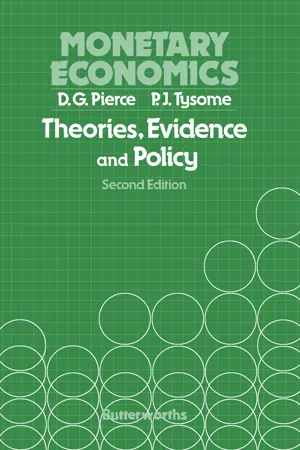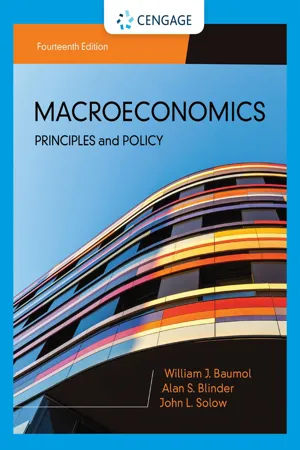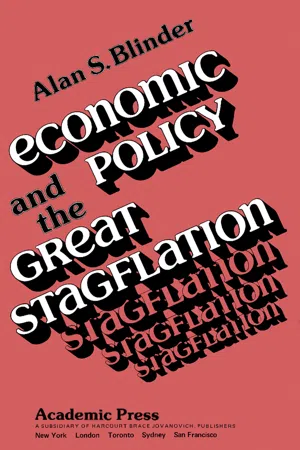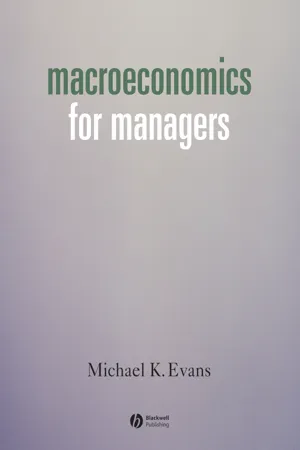Economics
Demand Pull Inflation
Demand-pull inflation occurs when the demand for goods and services exceeds their supply, leading to an increase in prices. This type of inflation is often associated with strong economic growth and can be caused by factors such as increased consumer spending, government stimulus, or investment. As demand outstrips supply, businesses may raise prices to balance the market.
Written by Perlego with AI-assistance
Related key terms
1 of 5
8 Key excerpts on "Demand Pull Inflation"
- eBook - ePub
- Alan Marin(Author)
- 2005(Publication Date)
- Routledge(Publisher)
Another definitional point might be raised here. One far too often comes across the statement, purporting to be a definition, that ‘inflation is a process of too much money chasing too few goods’. This purported definition is, in fact, an implicit explanation of inflation, not a definition, and it will be discussed under the causes of inflation and not as part of the definition.Figure 4.1 Change in equilibrium price level following shift in demand or supplyDemand-pull and cost-push
Much of the early attempts to explain inflation often divided the theories into two groups: first demand-pull, second cost-push. There are various meanings given to this distinction and these meanings have changed over time to an extent that the terms are often unclear and therefore we shall try to restrict our use to those cases where there should be no confusion. At one time the distinction was between those who believed that inflation was caused by shifts in aggregate demand as compared to those who thought that inflation was caused by shifts in aggregate supply. This distinction relates to the simplest of price theory models. If in Fig. 4.1 we consider a single market initially in equilibriumat a price P 0 then the price can rise to P1 for one of two reasons: either because the demand curve shifted from d 0 d 0 to d'd' while the supply curve remains at s 0s 0 or because the supply curve shifted from s 0 s 0 to s's' while the demand curve remains unchanged. Either of these would lead to a rise in price in the case of a single product and the demand-pull/cost-push distinction was simply applying this model to the economy as a whole.Our impression is that distinguishing demand-pull from cost-push on this basis is now much less popular. The reason is that the distinction just described will only be useful in the case of a once-and-for-all price rise rather than in the case of a continuing process of inflation. It perhaps made sense 30–40 years ago, when the rule was assumed to be stable prices and the question asked was what started off a particular episode of inflation. Once inflation has been going on for decades, the question of what originally started it so many years ago is not a very relevant one, as compared to discussing the conditions that allow inflation to continue. The demand-pull/cost-push distinction of demand curve shift versus supply curve shift is less useful for this. Once inflation has got under way, a shif t in the demand curve may itself lead to a rise in the supply curve as workers want higher wages and feel that firms can afford to pay them. Similarly, an increase in the supply curve could lead to a rise in the demand curve for products because workers have more money income. - eBook - ePub
- Krish Bhaskar, David F. Murray(Authors)
- 2015(Publication Date)
- Routledge(Publisher)
There are two further problems which we must mention here. Inflation is generally considered to be undesirable yet an annual increase in the general level of prices of, say, 1.5 per cent may be argued by some economists to be beneficial in stimulating economic growth whereas they would join the consensus of opinion against a 25 per cent per annum rise. The problem of deciding when the rate of increase in prices becomes unacceptable therefore remains. Secondly, a distinction is often made between price inflation which refers to the rate of increase of prices and wage inflation which refers to the rate of increase of money wages. Inflation is normally measured by the rate of increase of prices, although clearly wages and prices are closely related.Demand pull and cost push inflation
The models considered earlier in the book have generally assumed a downward sloping aggregate demand curve and an upward sloping aggregate supply curve which provides a convenient framework within which to consider the two main ways in which price inflation may occur.The first is generally known as Demand Pull Inflation and reflects a rightward shift in the aggregate demand curve as shown in Figure 15.1 . It is often loosely described as a situation where ‘too much money is chasing too few goods’ and is simply a situation where the demand for goods and services at the existing price level outweighs the supply, leading to an increase in the price level.Figure 15.1 The effect on the price level of an increase in aggregate demandIt is often argued that at less than full employment the aggregate supply curve is similar to that shown in Figure 15.1 but that as full employment is reached output cannot easily be increased, in the short run at least, and the aggregate supply curve becomes steeper as shown3 by the dotted line in Figure 15.1 . The effect of this is to generate a greater increase in the price level for a given movement in the aggregate demand curve.One source of theories of inflation is therefore concerned with the factors affecting the aggregate demand curve since this in turn affects the price level. These are the so-called demand pull theories. The second main approach to the theory of inflation is generally known as cost push inflation and considers the factors which might produce a leftward shift in the aggregate supply curve as shown in Figure 15.2 - eBook - PDF
Monetary Economics
Theories, Evidence and Policy
- David G. Pierce, Peter J. Tysome(Authors)
- 2014(Publication Date)
- Butterworth-Heinemann(Publisher)
In the 1950s and early 1960s, for example, it was common practice to distinguish between 'demand -puir and 'cost-push' explanations. This classification tried to distinguish between inflations that resulted from prices being pulled up by an excess demand for goods and services, and those that resulted from prices being pushed up by rising costs. A major objection to this classification is that excess demand can arise either because of an increase in demand or a fall in supply. The latter, of course, could be a consequence of an increase in costs, so that both demand-pull and cost-push theories could be seen as excess demand explanations of inflation. As a result the demand-pull versus cost-push distinction fell out of favour in the 1970s, being largely replaced by a classification which distinguished between economic and non-economic explanations of inflation. The non-economic explanations are regarded as sociological or socio-political, concentrating as they do on trying to explain the behaviour of trade unions and of prices in terms of sociological and political concepts. The economic theories, on the other hand, 190 Market theories of inflation 191 Market theories of inflation The inflationary gap model The first market theory of inflation we shall consider is one which draws an important distinction between situations of unemployment and that of full employment. The theory is usually identified with Keynes and called the inflationary gap' model. It is illustrated in Figure 9.1. A D Q is the initial aggregate demand curve, which generates an equilibrium level of income co-incidental with full employment {Y/P)f. Now suppose that there is an autonomous increase in Figure 9.1 The Keynesian inflationary gap aggregate desired expenditure which shifts the aggregate demand curve to ^ D i . The equilibrium level of real income is now {Y/P )u in excess of the full employment level and consequently unattainable. - eBook - PDF
Macroeconomics
Principles & Policy
- William Baumol, Alan Blinder, John Solow, , William Baumol, Alan Blinder, John Solow(Authors)
- 2019(Publication Date)
- Cengage Learning EMEA(Publisher)
Wage changes shift the aggregate supply curve and, therefore, change equilibrium GDP and the equilibrium price level. Copyright 2020 Cengage Learning. All Rights Reserved. May not be copied, scanned, or duplicated, in whole or in part. Due to electronic rights, some third party content may be suppressed from the eBook and/or eChapter(s). Editorial review has deemed that any suppressed content does not materially affect the overall learning experience. Cengage Learning reserves the right to remove additional content at any time if subsequent rights restrictions require it. 204 Part 2 The Macroeconomy: Aggregate Supply and Demand There is a straightforward way of looking at the economics behind this process. Inflation arises because buyers are demanding more output than the economy can produce at normal operating rates. To paraphrase an old cliché, there is too much demand chasing too little supply. Such an environment encourages price hikes. Ultimately, rising prices eat away at the purchasing power of con- sumers’ wealth, forcing them to cut back on consumption, as explained in Chapter 8. In addition, exports fall and imports rise, as we learned in Chapter 9. Eventually, aggregate quantity demanded is scaled back to match the economy’s capacity to produce—graphically, the economy moves back along curve DD from point E to point F. At this point the self-correcting process stops. In brief: If aggregate demand is exceptionally high, the economy may reach a short-run equilibrium above full employment (an inflationary gap). When this occurs, the tight situation in the labor market soon forces nomi- nal wages to rise. Because rising wages increase business costs, prices increase; there is inflation. As higher prices cut into consumer purchasing power and net exports, the inflationary gap begins to close. As the inflationary gap closes, output falls and prices continue to rise. - eBook - PDF
- Alan S. Blinder(Author)
- 2013(Publication Date)
- Academic Press(Publisher)
Such an increase could be caused, for example, by an increase in the money supply, a tax cut, or a change in private spending habits. How will prices and output react to this shock? As I have already suggested, prices are basically fixed in the very short run, and hence will show no immediate reaction. The increase in demand manifests itself entirely in greater real output. After a while, however, the increase in demand leads to depleted inventories and higher produc-tion costs; at this point prices begin to rise while the expansion of real output continues. As more time passes, however, more and more factor prices are adjusted upward and inflationary pressures intensify. The re-sulting higher prices for goods and services depress demand for reasons discussed eariier. Thus output begins to fall back toward its natural level while prices continue to rise. Finally, since we have assumed the 2. E x p l a n a t i o n s for Stagflation 13 Figure 2-3. The o v e r s h o o t i n g e x p l a -nation of stagflation. -> β / S L Output demand stimulus was a one-shot event, output returns to its natural rate and inflation returns to zero.^ There are thus three characteristic phases of an inflation fueled by excessive aggregate demand, and Figure 2-3 is a convenient way of depicting them. (In the figure, the increase in aggregate demand is rep-resented by the shift from demand curve DQDO to demand curve D,D,; curves SS and LL are, respectively, the intermediate-run and long-run supply curves. The short-run supply curve would just be a horizontal line through point £ , and is omitted to avoid cluttering the diagram.) Beginning from an initial equilibrium at point E, where demand curve DQDQ intersects both SS and LL, the economy expands without inflation to point B. This is the first phase of growth with inflation. Next, however, costs and prices begin to rise as the aggregate supply curve begins to acquire some slope. - eBook - PDF
- Michael K. Evans(Author)
- 2008(Publication Date)
- Wiley-Blackwell(Publisher)
As a result, demand declines and unemployment rises for a while. Thus even if Fed policy has been credible, workers will demand an increase in their paychecks equal to the rise in inflation caused by higher commodity prices. That means the inflation rate must start to decrease before employees are convinced the value of their paychecks will not erode further. Because of these lags, inflation will rise even in well-managed economies when malign supply shocks occur. We emphasize that when a major supply shock does occur, the money does not vanish into thin air; it is redistributed from one group of people to another. Even if the group benefiting from this distribution is outside the US, the fact that the world is on a de facto dollar standard means that most of that money will either be spent on US exports of goods and services, or will be deposited in dollar-denominated financial instruments. As a result, the decline in aggregate demand from this supply shock is far overstated simply by looking at the figures for real consumption and disposable income. That was probably the major mistake made by both Federal Reserve and private sector economists in 1973. After that, the Fed recognized that because of sticky prices and wages, inflation is likely to increase over the next year or two even if demand has slackened, so more emphasis has been put on fighting CAUSES OF AND CURES FOR INFLATION 297 inflation and less on worrying about whether the economy is about to head into recession. That is another reason why the ripple effects from energy shocks have become increasingly milder. 8.7 The beginnings and ends of hyperinflation The importance of expectations in determining inflation can also be seen by exam- ining the abrupt way in which hyperinflations come to a halt. - eBook - PDF
- Various(Author)
- 2021(Publication Date)
- Routledge(Publisher)
So the (quantita- tive) pressure of inflation has increased relative to the original quasi- equilibrium situation. The resulting increase in the excess demand for commodities is less than the actual increase in the state's purchases of commodities, but there also arises a certain increase in the excess de- mand for labour-services. However, the increase in the excess demand for labour-services only corresponds to the increase in the excess demand for commodities in the sense that they cause the same percentage rise per unit of time in the wage-rate and price respectively. A decrease in the state's purchases of commodities may be treated in just the same way and leads to the opposite result, with a fall in the price-wage ratio and in the speeds of the rises in the price and in the wage-rate. 4. Decline in productivity Another important companion of inflation is often a decline in pro- ductivity. It might seem that such a decline in productivity may be illustrated in much the same way as was the increase in the state's purchases of commodities, for what happens in both cases is that there is a smaller supply of commodities available from the same input of labour-power to meet the private demand for commodities. The rela- tionships will certainly be of this type if the decline in productivity is temporary, for example, a bad harvest, but even in this case the reasoning of Section 3 cannot be applied, because the temporary decline in productivity must in the nature of the matter be something which does not last and is not expected to last either (just as with an un- expectedly bad harvest). What we wish to deal with is the effect of a permanent decline in productivity which the entrepreneurs expect to persist in the future. - eBook - PDF
- Graham Mallard(Author)
- 2017(Publication Date)
- Red Globe Press(Publisher)
Such a spiral can only be broken by the government resisting the temptation to further validate the shock, allowing the economy to correct itself. In the 1970s Milton Friedman (see Section 14.9) famously said inflation is ‘always and everywhere a monetary phenomenon’. By this he meant it’s fuelled only by the government expanding the money supply too quickly. Remember our illustration of the quantity theory of money in Section 11.2 – which Fried-man was resurrecting by saying this – of buying shoes for a child: expanding the money supply too quickly compared with the rate at which the economy is growing inevitably causes inflation. Friedman wasn’t saying that inflation is only caused by the government expanding the money supply too quickly: the analysis above shows that inflation can be initially caused by both supply and demand shocks. Rather, he was saying that inflation is only sustained if it’s either accommodated or validated by expansionary monetary policy. If the economy is allowed to correct itself, the inflation initially caused by a demand or supply shock will be relatively short lived. The problem is that ‘relatively short lived’ can actually be a long and painful period. 11.4 inflation, unemployment and expectations In 1958, William Phillips, a professor at the London School of Economics, dis-covered a remarkably uniform, negative relationship between the rate of wage inflation and the rate of unemployment in the UK over a period of a hundred years – a relationship illustrated in Figure 11.7a. In the 1960s Robert Solow and Paul Samuelson showed the relationship to hold more generally between the rates of inflation and unemployment, which led to the conventional Phillips curve displayed in Figure 11.7b. Key term: the Phillips curve The Phillips curve shows a negative association between the rates of inflation and unemployment of an economy.
Index pages curate the most relevant extracts from our library of academic textbooks. They’ve been created using an in-house natural language model (NLM), each adding context and meaning to key research topics.







